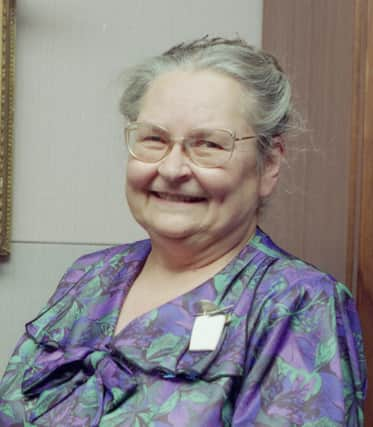Obituary: Helen Cargill Thompson, librarian and art collector


Often, at private views at galleries in both Glasgow and Edinburgh, one would spot an unmistakable figure: a well-spoken lady in a biege mackintosh, her long grey hair braided around her head. Helen Cargill Thompson was an intent browser. She always knew what she was looking at, and what she liked. Things she liked, she often purchased.
Helen was born in Burma where her father worked as a merchant trader; her great grand-uncle had been a founder of Burmah Oil. On the eve of war in 1939, Helen, her parents and two brothers returned to Glasgow to live with her grandparents in Mirrlees Drive, close to the Botanic Gardens. Helen’s father was a liberal who enjoyed hosting salon-style intellectual discussions, and Helen – when she was not away at Cheltenham Ladies College – was encouraged to join in, pitting her wits against professors, judges and senior clergy. She spent her holidays in France as a companion to an elderly lady.
Advertisement
Hide AdAdvertisement
Hide AdShe studied Physiology and Pharmacology at St Andrews University, and went on to do a PhD (which involved research into the contraceptive pill) at Edinburgh University. However, after ten years as a research scientist she wanted a change, and when the Office for Scientific Information launched a campaign to recruit scientists to work in libraries as information officers, she applied and was accepted. In 1970 she came to work in the Andersonian Library at Strathclyde University, trained in librarianship and never looked back.
In 1982 she was appointed head of the library’s new Reference and Information Division, a post she held until her retirement in 1999. Many students received their induction to the library from Helen, and later found that the rather forbidding librarian with the braided hair would go out of her way to help when they needed it. Just before she retired, she was awarded a medal by the Princess Royal for services to librarianship.
Her interest in art had begun in childhood when she was taken by her parents to museums and galleries in Glasgow. She liked to say she began collecting in earnest in 1985 “when Maggie Thatcher brought down income tax and I had some spare money”. She became a regular at openings, with many galleries reserving a seat especially for her, and enthusiastically attended graduate shows at Scottish art colleges, indulging her particular interests in painting and silversmithing.
Her tastes were eclectic and she bought widely, once saying that she preferred “to put jam on the bread of youngsters, rather than established artists”, although she did buy the work of some well-known artists too. She did not regard her collection as an investment, gifting some 350 paintings to Strathclyde University in 1999, and gifting part of her silverware collection to Glasgow School of Art.
She lived frugally, never taking a taxi to a gallery, saying this allowed her to spend more on art. She was adept at turning up at a favourite gallery when she knew there would be a fresh pot of coffee brewing.
Helen, who never married, was a staunch supporter of a variety of charities. She was president of the Graduates Association at Strathclyde University, and an active supporter of its fundraising events. When the Association hosted biennial fashion shows to raise money for water purification in Malawi, she joined fellow staff and graduates on the catwalk, on one occasion spying a teal silk dress on a size 6 model and promptly commissioning the young designer to size it up to a 22.
At the age of 73, as treasurer of Charity Education International, she travelled to Kakina in Bangladesh where Uttar Bangla University College had been founded to encourage the poorest people into higher education. As well as auditing the library, she spotted a derelict Raj-era building in the grounds and donated a substantial sum to help renovate it. The main hall in the college is named after her.
She was treasurer of the Scottish Pakistani Association, looked after the library for the Glasgow and West of Scotland Family History Society and was a loyal supporter of the National Trust for Scotland, for which she was honoured by Prince Charles, and to which her house in Mirrlees Drive has been bequeathed.
Advertisement
Hide AdAdvertisement
Hide AdAfter the deaths of her parents, she continued to live in the family home, which retained many original features going back to the early years of the 20th century, including the original leather and silk wallpaper, and a bell system for summoning servants to various rooms. She worked hard to maintain it – when the lino in the kitchen needed replacing, she persuaded the original manufacturers to recreate the long-discontinued pattern by hand. She hoped the house could become a museum, the upper-middle-class sibling of Glasgow’s Tenement House.
She even offered tours of the house in aid of charity, inviting guests to “the CT experience”. Visitors report seeing still-wrapped paintings stacked against the wall in every room, silver objects in boxes behind the sofa and her collection of vintage wines, ports and champagnes making its home on her father’s full-size billiards table.
Artists and dealers paid tribute to “an amazing woman who supported the arts in so many ways”, who did not suffer fools gladly, but was also generous and mischievously funny. One art dealer said: “There has never been another collector like her, who supported artists like no other.”
She died in hospital in Glasgow after a short illness. She is survived by seven nieces and nephews.
SUSAN MANSFIELD